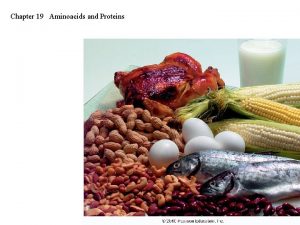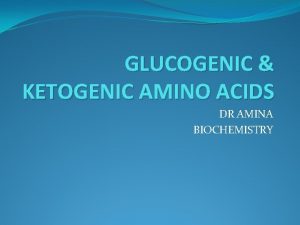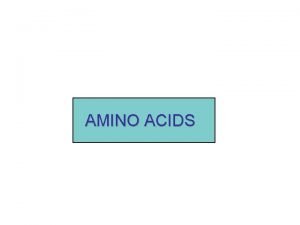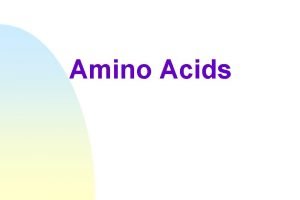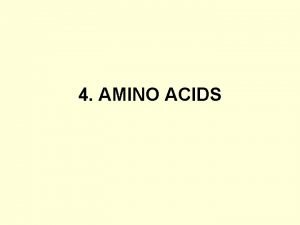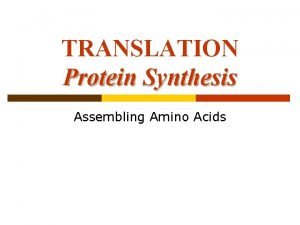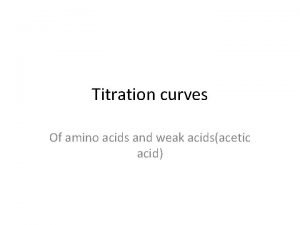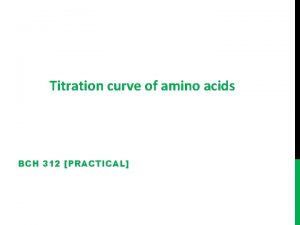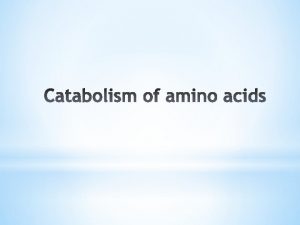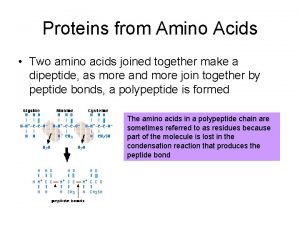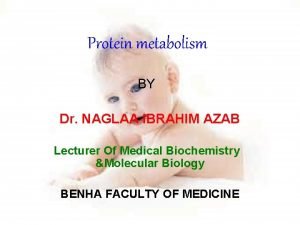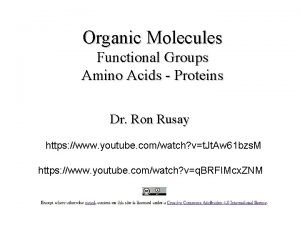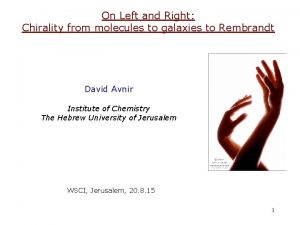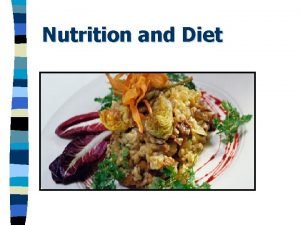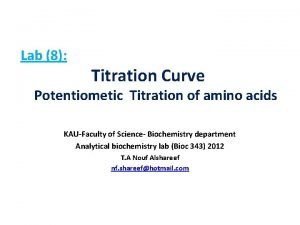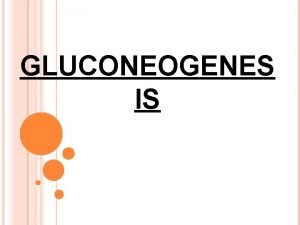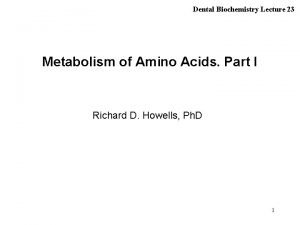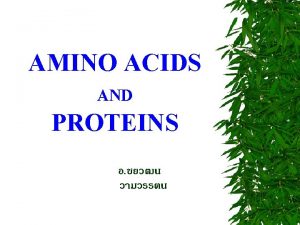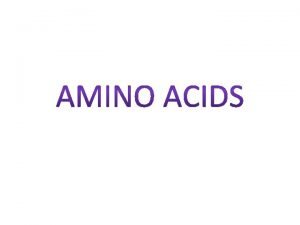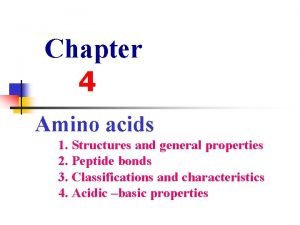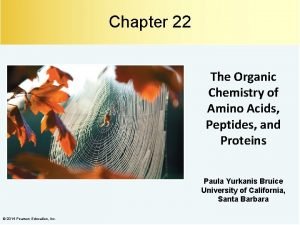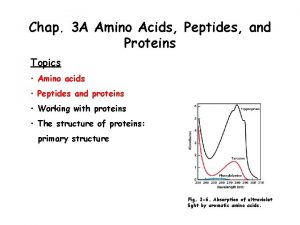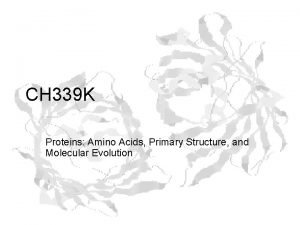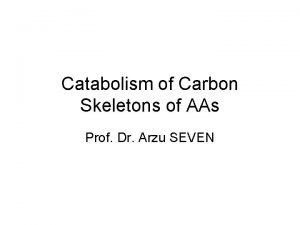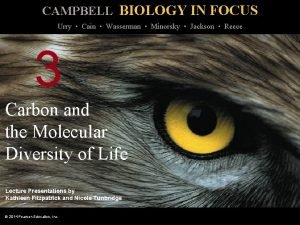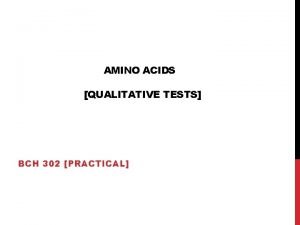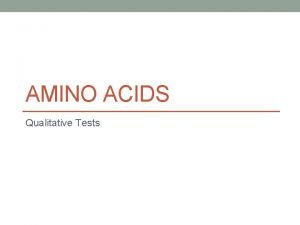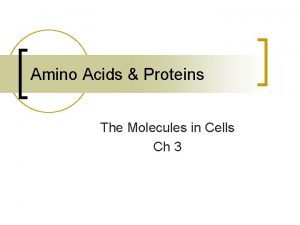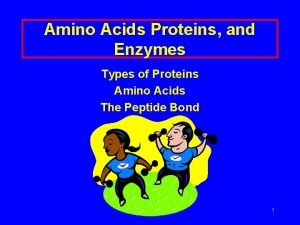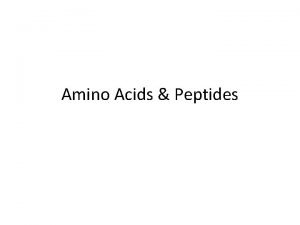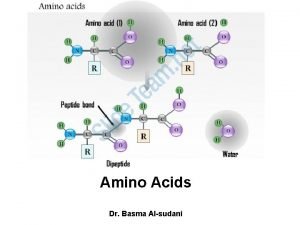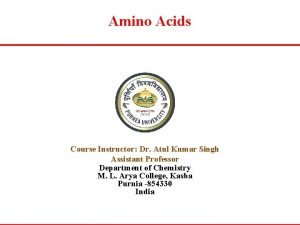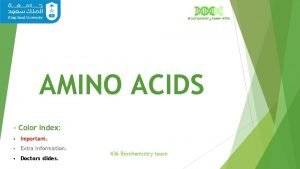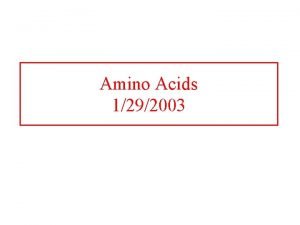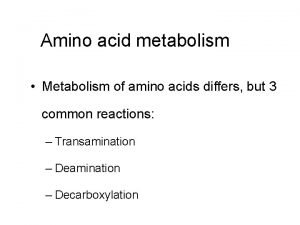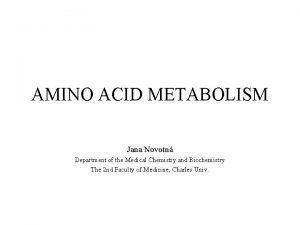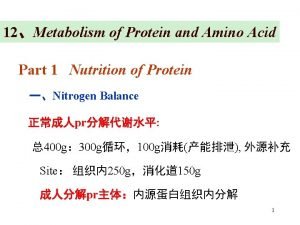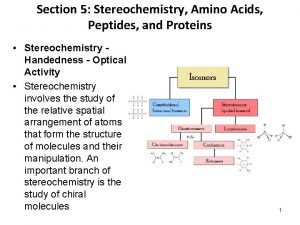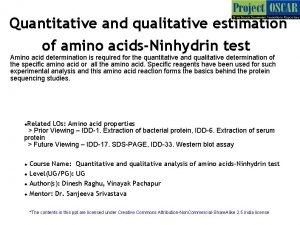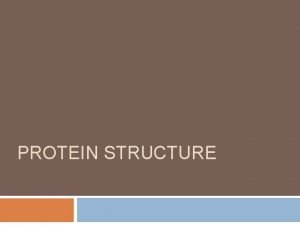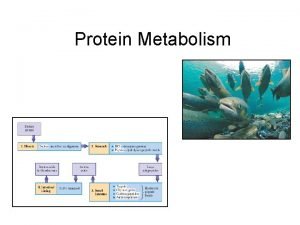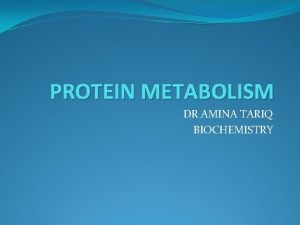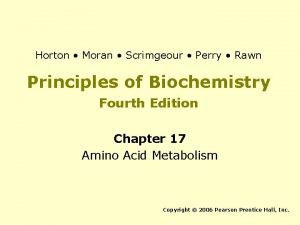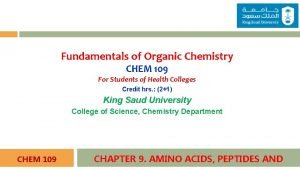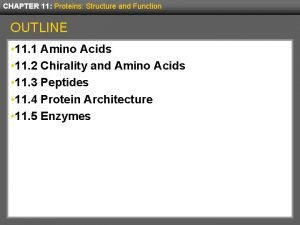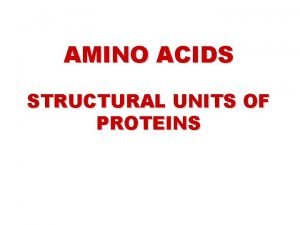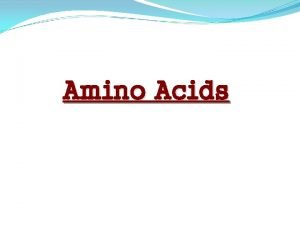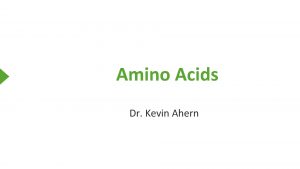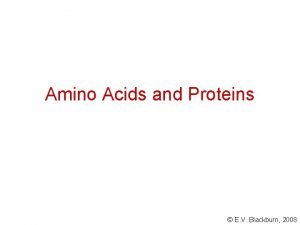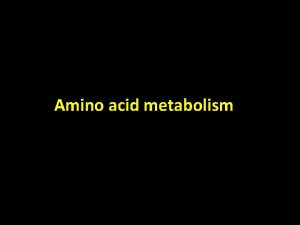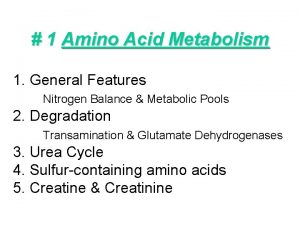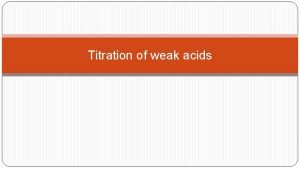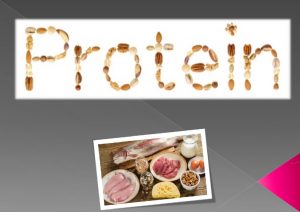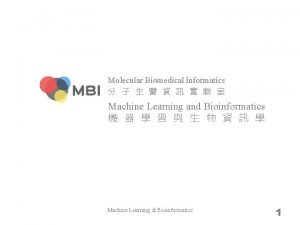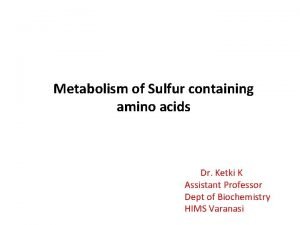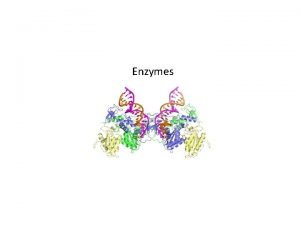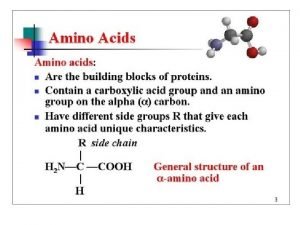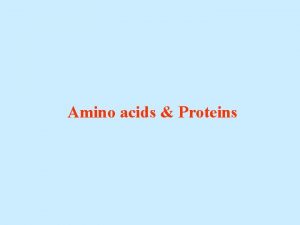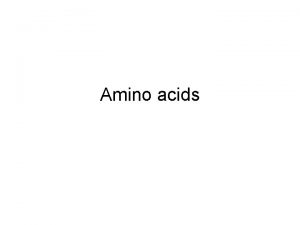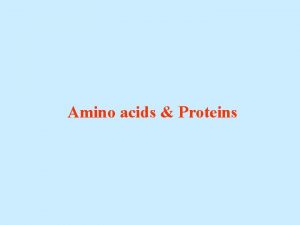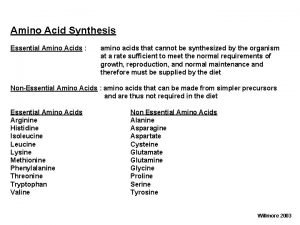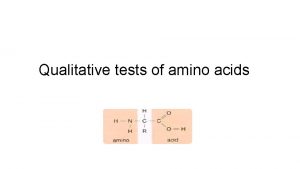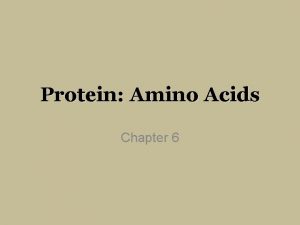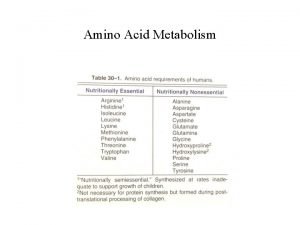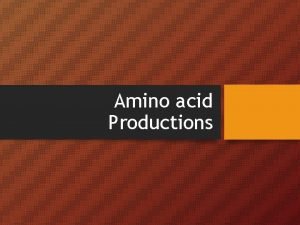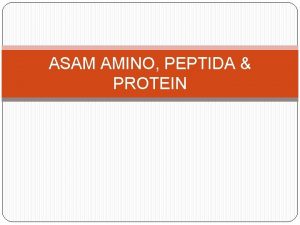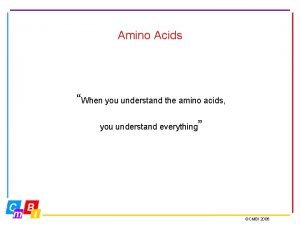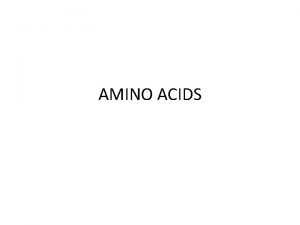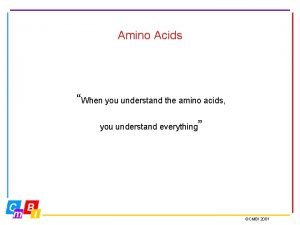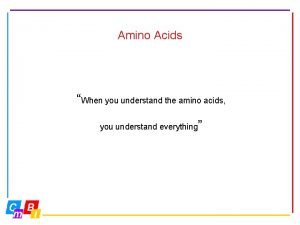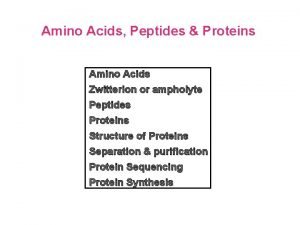Protein and Amino Acids We often associate protein



























































- Slides: 59

Protein and Amino Acids • We often associate protein in our diets with strength building properties and meat we eat with protein. Protein is a vital structural and regulating substance in all cells and tissues of the body. • Meat is a good source of protein, but so are other foods such as, milk, eggs, legumes, and many grains and vegetables. “Lecture -5 Protein and Amino Acids Power. Point" by Dr. Michael Kobre, Achieving the Dream OER Degree Initiative, Tompkins Cortland Community College is licensed under CC BY 4. 0

Protein • Chemically, proteins contain the same atoms as CHO and lipids-carbon (C), hydrogen, (H), and oxygen (O); but proteins also contain an additional atom, nitrogen (N). Nitrogen atoms give the name amino (nitrogen containing) to the amino acid molecules that are links in the structure that makes proteins. Amino acids are the building blocks of proteins.

Amino Acids • All amino acids have the same base structure. a central carbon (C), atom with a hydrogen (H), an amino group(NH 2), and an acid group (COOH) attached to it. • Because carbon atoms need to form four bonds so a fourth bond must be filled. It is this 4 th bonding site that makes each amino acid from others. This 4 th attachment is known as the side chain or an “R” group.

Amino Acids • The side or “R” groups on different amino acids vary making proteins more complex and functional than both carbohydrates or lipids. • A protein is usually made up of varying types of amino acids, each one having some of the 20 different side chains.

Amino Acids • The simplest amino acid is glycine. It has a single hydrogen atom as it’s “R” group or side chain. Other Amino acids have more complex side groups, making them differ in size shape, electrical charge and function.

Amino Acids "Amino. Acidball. svg" by Yassine. Mrabet is licensed under CC BY 4. 0 "A Brief Guide to the Twenty Common Amino Acids" is licensed under CC BY-SA 4. 0

Nonessential Amino Acids • More than half of the amino acids in nutrition are nonessential, meaning that our liver can synthesize them for use. Protein in foods usually supply these but it is not essential that it does. If we have nitrogen available to form the base amino group and fragments from CHO and fat. Our cells can synthesize any nonessential AA.

Essential Amino Acids There are nine important amino acids that the human body either cannot synthesize at all or cannot synthesize in large enough quanities to meet functional requirements. These 9 essential amino acids must be supplied by our diets.

Conditionally Essential Amino Acids • In some cases a nonessential amino acid becomes essential. E. g. the body normally uses the essential amino acid phenylalanine as a base to synthesize the amino acid tyrosine (nonessential). But if our diets fail to supply enough phenylalanine, or for some reason we cannot make the conversion, then tyrosine becomes conditionally essential.

Proteins • Our cells synthesize protein by linking amino acids together in an infinite variety of sequences to make thousands of different proteins in the body. Each amino acid is attached to adjoining amino acids by a peptide bond. • Condensation reactions, a type of chemical reaction, bond amino acids together forming amino acid chains.

Amino Acid Chain Length • Two amino acids bonded together form a dipeptide. • Three amino acids bonded together forms a tripeptide. • As more amino acids are attached to the chain, a polypeptide is formed. Most proteins in the body are a few dozen to several hundred amino acids long.

Protein • The polypeptide chains of formed protein will twist into a variety of complex shapes depending on their different amino acid sequences. • The characteristics of the side “R” groups on the amino acids in the chain are responsible forming the protein’s shape, structure, electrical properties and it’s function in the body.

Protein Structure "Protein primary structure. svg" by National Human Genome Research Institute is licensed under CC BY 4. 0 "Main protein structure levels en. svg" by Ladyof. Hats is licensed under CC BY 4. 0

Protein Damage • Protein can be damaged. When proteins are subjected to above normal levels of heat, acid, or other conditions their stability can be disrupted and protein can become denatured. These changes cause protein to uncoil and lose their shapes and function. • Past a certain point, protein is irreversibly damaged and can no longer function it’s intended purpose.

Digestion of Protein • The protein we consume in foods do not become functioning body protein directly. Protein in foods we eat supply the amino acid building blocks we need for synthesis of body protein. • Just like carbohydrates and lipids, there are specific enzymes that digest consumed protein and long polypeptides down into tri and dipeptides and then into AAs.

" Protein-Digesting Enzymes. N. jpg" by Open. Stax College is licensed under CC BY 4. 0 "Mechanical and Chemical Digestion. N. jpg" by Open. Stax College is licensed under CC BY-SA 4. 0

Digestion of Protein • In the stomach: the major event is the partial breakdown (hydrolysis) of proteins. • Hydrochloric acid uncoils (denatures) each protein’s tangled strands so that digestive enzymes can attack the peptide bonds • The HCL also converts the inactive enzyme pepsinogen to active pepsin.

Digestion of Protein • In the small intestine: several pancreatic and intestinal proteases (enzymes that hydrolyze protein) hydrolyze them further into short peptide chains -> tripeptides -> dipeptides, and amino acids. • Peptidase: enzymes on the membrane surfaces of the intestinal cells split most of the di and tripeptides into AA.

Digestion of Protein "Protein digestion. PNG" by Pdeitiker is licensed under CC BY 4. 0

Absorption of Protein • A number of specific active transport protein carriers bring amino acids, undigested dipeptides and tripeptides into the intestinal cells. • Once moved inside the intestinal cells, amino acids may be used for energy or to synthesize needed compounds for intestinal cells. Those amino acids not used by intestinal cells are transported into the capillaries and to the liver for processing and use by other body cells.

Roles of Protein in the Body • Whenever our body is growing, repairing, or replacing tissue, proteins are always involved. • Protein’s roles in the body are to facilitate, regulate and other times it is to become part of a cell or tissue structure. • Protein’s versatility is what makes it so important in body structure, and regulation and functioning.

Protein Roles in the Body • Some of the important roles are: • As building materials (e. g. muscles, bones) • As enzymes (chemical reactions) • As hormones (messenger molecules) • As regulators (of fluid balance) • As acid-base regulators (in body fluids) • As transporters (hemoglobin) • As antibodies (immune system)

Roles of Protein in the Body Sometimes protein is used as source to make energy and glucose: • Even though proteins are mostly needed to perform specific functions that only they can perform, they will be cannibalized in the body to provide energy during times of low energy intake.

Protein Metabolism • Different types of proteins are constantly being synthesized and broken down as needed in the body. • The body’s assimilation of amino acids into proteins and its release of amino acids via protein degradation and excretion can be tracked by measuring nitrogen balance.

Protein Metabolism • Nitrogen Balance: The amount of nitrogen consumed as compared with the amount of nitrogen excreted in a given period of time. • Positive nitrogen balance: is found in growing infants, children, pregnant women, and people recovering from protein deficiency conditions.

Protein Metabolism • Negative nitrogen balance: is found in people who are starving or suffering from severe stress such as burns, injuries, infections, and fever. The body loses nitrogen as it breaks down muscle and other proteins for energy. • In healthy adults, protein synthesis balances with degradation.

Protein Metabolism • An inadequate energy intake or low protein intake may force the body to use amino acids as fuel, creating a negative nitrogen balance. • Protein eaten in excess of our body’s need is digested, converted and stored as body fat.

Protein Quality • The quality of protein in the diet is of great concern when making nutrition recommendations. • To make sufficient protein in the body, a cell must have all the needed amino acids available simultaneously. • The liver can produce any nonessential amino acid that may be in short supply so that the cells can continue protein production.

Limiting amino acids • If an essential amino acid is missing, the body’s cell must dismantle its own proteins to make the essential amino acids. • In order to prevent this cell protein breakdown, dietary protein must supply at least nine essential amino acids. • Lysine, Methionine, Theronine, and Tryptophan are the four most likely to be limiting in the diet, which when missing cause deficits in the body.

Complete Proteins are High Quality • Complete proteins contain all the essential amino acid types similar to those that humans require for normal functioning. • Generally, in our diets, proteins from animals (meats, fish, poultry, cheese, eggs, and milk) are complete.

Complementary Proteins • In general, plant proteins are of lower quality (not complete) when compared animal proteins. Plants also offer less protein per weight. Because of this, many vegetarians improve the quality of proteins in their diets by combining different plant-protein foods that have different but complementary amino acid patterns to help obtain all the needed essential amino acids required for normal body functions.

Complementary Proteins • Mutual Supplementation: is a strategy of combining two protein foods in a meal so that each food provides the essential amino acid(s) lacking in the other food being consumed. Mutual supplementation is a dietary strategy that helps brings complementary proteins together in a meal so all the essential amino acids are available for cells to build, repair and allow functioning to take place.

Complementary Proteins • An example is eating beans and rice in a meal. Together these two foods provide a balanced array of amino acids needed for our body’s functioning. • It is not always necessary to balance amino acids every each meal when protein intake is varied and energy intake is sufficient.

Protein Digestibility • Ideally, a complete protein is digestible enough to provide all the amino acids needed for our cell’s protein synthesis. • These types of protein in the diet are considered High-quality proteins. • Protein digestibility depends on such factors as a food protein’s source and other foods consumed with it.

Protein Digestibility • When we compare different proteins the digestibility of most animal proteins is high (90 -99 percent digestible). • Plant proteins are less digestible (70 -90 percent), in part because they are contained within plant cell walls that have fiber that resist digestion.

Protein Digestibility • A Reference Protein: is one that is tested to be the most complete and digestible protein. It is a protein we compare all other proteins against. • The egg protein can be used as a standard for measuring protein quality; it is given a reference value of 100. • The quality of other food proteins is determined based on how they compared with egg protein’s structure and it’s amino acid content.

Protein-Energy Malnutrition • In some areas of the world people have a hard time securing adaquit sources of protein. Protein-kcalorie malnutrition: is a deficiency of protein, energy, or both. This condition includes Kwashiorkor, Marasmus, and some instances in which they can overlap. Although PEM touches many adult lives, it most often strikes early in childhood and can be devastating to children.

Protein-Energy Malnutrition • Inadequate food and caloric intake leads to poor growth in children and also to weight loss and wasting in adults. • Children who are thin for their height may be suffering from acute PEM (recent severe food deprivation), whereas children who are short for their age have experienced chronic PEM (long term food deprivation) and they may not have been able to grow or develop normally.

Protein-Energy Malnutrition • Poor growth due to PEM is easy to overlook because a small child may look quite normal, but being small for their age is the most common sign of malnutrition. "1968 5 Nigeria CDC. png" by CDC/ Dr. Lyle Conrad is licensed under CC BY 4. 0

Protein-Energy Malnutrition • PEM, is most common in Africa, Central America, South America, the Middle East, and East and Southeast Asia. • In the U. S. , many homeless people and folks living in substandard housing in inner cities and rural areas have been "Malnurished Afghan Child. jpg" by Capt. John Severns is licensed under CC BY 4. 0 diagnosed with this condition.

Protein-Energy Malnutrition • Besides folks living in poverty, many elderly people living alone and adults who are addicted to drugs and alcohol are frequently victims of protein energy malnutrition. • Adult PEM is also seen in people hospitalized with chronic infections such as AIDS or tuberculosis. These infections can deplete body proteins, demand more energy, cause nutrient losses, and effect metabolic processes. Also, poor intake during illness (not want to eat) impairs function and recovery.

Protein-Energy Malnutrition • This condition is also common in those suffering from the eating disorders like anorexia nervosa. • Prevention of protein energy malnutrition emphasizes frequent nutrient-dense, energy-dense meals and, equally important, resolution of the underlying primary cause such as poverty, addictions, infections, and illness.

Rehabilitation of PEM • If caught in time, the life of a starving individual may be saved with nutritional intervention. Treatments will require careful nutrition correction to help strengthen and rehydrate the body so normal physiological functioning can return.

Health Effects of Protein • While many of the world’s people struggle to obtain enough food energy and protein, developed countries like the United States have abundant food and problems of excess nutrition are seen. • Over consumption of protein offers no benefits and may pose additional health risks.

Protein Intake and Heart Disease • Foods rich in animal protein tend to be rich in saturated fats. Because of this, it is not surprising to find a correlation between excessive animal-protein intake and heart disease, independent effects are currently being researched.

Heart Disease • Some research has shown us that elevated levels of the amino acid homocysteine in the blood may be an independent risk factor for heart disease. • Researchers do not yet understand the many factors that can raise homocysteine in the blood or whether elevated levels are a cause or an effect of heart disease but there seems to be a correlation.

Heart Disease and Protein • Until we can determine the exact role homocysteine plays in heart disease, they are following many leads in the pursuit of the answers. • What is coffee’s role? • Suboptimal levels of B vitamins? • Soy or plant versus Animal proteins?

Cancer and Protein • Like heart disease, the effects of protein and fats on cancer cannot be easily separated. Some studies have shown a correlation between high intakes of animal proteins and some cancers. e. g. colon, breast, kidney, pancreas, prostate cancers to name a few.

Bone Loss and Protein • We also know through research that protein intake increases calcium excretion in the body. • Research suggests that calcium losses occur when protein intake is high because these diets are typically low in fruits and vegetables and favor acid production in the body. our skeleton responds to this by giving up its calcium to help buffer the acid. Eating more fruits and vegetables when consuming a high protein diet helps lessen acidity in the body.

Controlling Weight • Protein-rich foods in the diet are often high in lipids that contribute to obesity and it’s health risks. • Weight loss diets that encourage a highprotein intake are rarely effective in weight loss over the long term.

Kidney Disease • Being able to excrete the waste products of protein metabolism depends on an adequate water intake and having healthy kidneys. A high protein dietary intake increases the work load of the kidneys. • The best way to help slow progression of kidney disease is to restrict excess dietary protein.

RDA Protein • The recommended protien intake for adults is 0. 8 grams per kilogram of healthy body weight per day. • When expressed as a percentage of energy intake, the protein requirements makeup about 10 percent of our total daily energy intake.

Protein and Amino Acid Supplements • May websites and health-food stores, and magazine articles advertise a wide variety of protein supplements, and sometimes folks takes these supplements for different reasons. • Athletes will take them to build muscle. Dieters sometimes take them thinking they will lose weight. People take them to cure herpes and other medical aliments.

Protein and Amino Acid Supplements • Protein supplements don’t work these miracles, and in many cases they can be very harmful… • Exercising muscle builds muscle; protein supplements do not, and most all athletes do not need them. • Single amino acids that are often found in these supplements do not occur naturally in foods and offer no benefit to the body.

Protein and Amino Acid Supplements • The human body’s digestive tract it’s cells and their physiology is not designed to handle the high concentrations and unusual combinations of amino acids found in supplements. An excess of one amino acid can create such a demand for a protein carrier in cells that it prevents the absorption of other needed amino acids, leading to a deficiencies.

Protein and Amino Acid Supplements • Many times with supplement use those amino acids enter in excess, creating the possibility of a toxicity in cells. • In two cases, recommendations for single amino acid supplements have led to widespread use. The use of lysine to prevent or relieve the infections that cause herpes outbreaks, and using tryptophan to relieve pain, depression, and insomnia.

Protein and Amino Acid Supplements • A review of current research shows that lysine may help suppress herpes infections to some extent in some individuals and appears to be safe (up to 3 -grams per/day) when taken in divided doses with meals. • Tryptophan is also shown effective with respect to pain and sleep, but its use for these purposes is still being researched.

Protein and Amino Acid Supplements • Daner has been proven: e. g. a study was performed were 1500 people who elected to take a high dose of trytophan supplements and many developed a rare blood disorder known as eosinophilismyalgia syndrome. This condition is characterized by severe muscle pain, extremely high fever, and in over three dozen reported medical cases, death.

Protein and Amino Acid Supplements • The use of most amino acid supplementation is inappropriate for most people especially for the following folks: Most women of child bearing age. • Pregnant and lactating women. • Infants, children, and adolescents. • Elderly people, folks with mental conditions. People with protein metabolic disorders. Care and medical advisement should be followed before use.
 Protein amino acids
Protein amino acids B-pleated sheet
B-pleated sheet Purely ketogenic amino acids
Purely ketogenic amino acids Why is lysine basic
Why is lysine basic Glucogenic and ketogenic amino acids
Glucogenic and ketogenic amino acids Difference between hydrophobic and hydrophilic amino acids
Difference between hydrophobic and hydrophilic amino acids Codon wheel
Codon wheel Titration curve of alanine
Titration curve of alanine Titration curve of amino acids
Titration curve of amino acids Deamination of amino acids
Deamination of amino acids Two amino acids joined
Two amino acids joined Transdeamination of amino acids
Transdeamination of amino acids 20 amino acid structure
20 amino acid structure Chirality definition
Chirality definition N
N Amino acid titration curves
Amino acid titration curves Glucogenic amino acid
Glucogenic amino acid Plp mechanism transamination
Plp mechanism transamination Amino acids groups
Amino acids groups Basic amino acids
Basic amino acids Www.chemsheets.co.uk
Www.chemsheets.co.uk Optical properties of amino acids
Optical properties of amino acids Epsilon amino
Epsilon amino Serylglycyltyrosylalanylleucine
Serylglycyltyrosylalanylleucine Diphthamide
Diphthamide Non essential amino acids mnemonics
Non essential amino acids mnemonics Dehydration synthesis of amino acids
Dehydration synthesis of amino acids Aromatic amino acids
Aromatic amino acids Phenol containing amino acids
Phenol containing amino acids Phenol group amino acid
Phenol group amino acid Peptide bond dehydration synthesis
Peptide bond dehydration synthesis Properties of amino acids
Properties of amino acids Biomedical importance of amino acids
Biomedical importance of amino acids Are amino acids negatively charged
Are amino acids negatively charged Conditionally essential amino acids
Conditionally essential amino acids Glutamate isoelectric point
Glutamate isoelectric point Amino acids are building blocks of
Amino acids are building blocks of Oxidative deamination of glutamate
Oxidative deamination of glutamate Glucogenic amino acid
Glucogenic amino acid Non essential amino acids mnemonics
Non essential amino acids mnemonics What is protien
What is protien Quantitative estimation of amino acids by ninhydrin
Quantitative estimation of amino acids by ninhydrin Protein structure
Protein structure Protein digestion
Protein digestion Transdeamination of amino acids
Transdeamination of amino acids 17/35
17/35 Acid base properties of amino acids
Acid base properties of amino acids Salt bridge amino acids
Salt bridge amino acids Pvt tim hall
Pvt tim hall Upon hydrolysis of fibron which amino acids are produced?
Upon hydrolysis of fibron which amino acids are produced? Alpha carbon amino acid
Alpha carbon amino acid Amino acid name
Amino acid name Transdeamination of amino acids
Transdeamination of amino acids Ketogenic amino acids
Ketogenic amino acids Titration of amino acids
Titration of amino acids What is made of amino acids
What is made of amino acids Wikipedia amino acids
Wikipedia amino acids Importance of sulphur containing amino acids
Importance of sulphur containing amino acids What is made of amino acids
What is made of amino acids Importance of sulphur containing amino acids
Importance of sulphur containing amino acids

